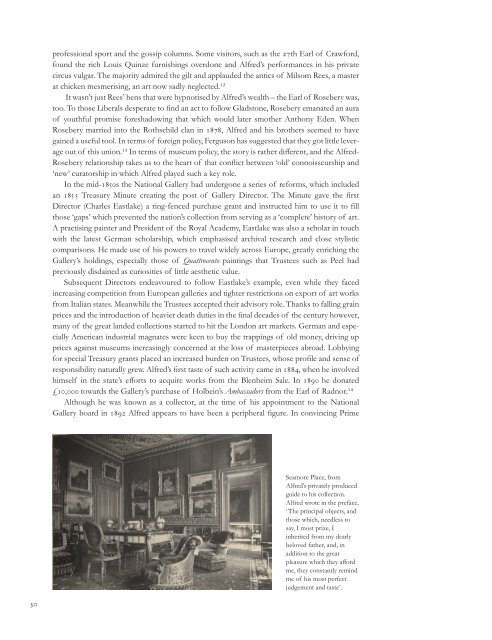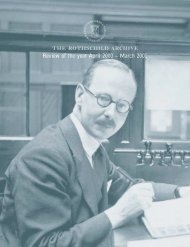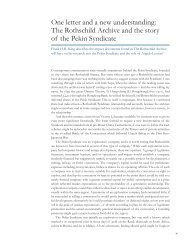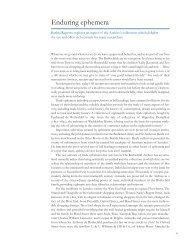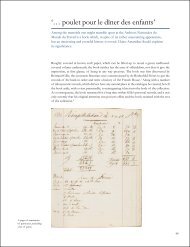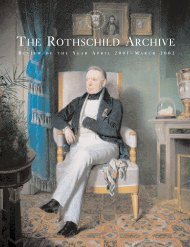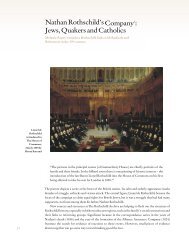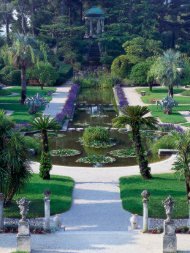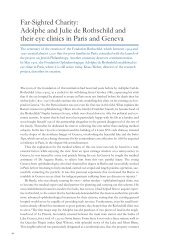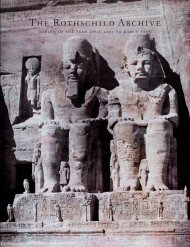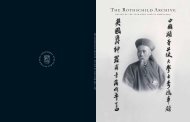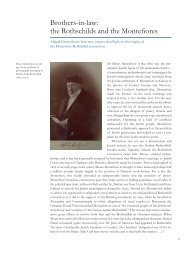Alfred de Rothschild as collector - The Rothschild Archive.
Alfred de Rothschild as collector - The Rothschild Archive.
Alfred de Rothschild as collector - The Rothschild Archive.
Create successful ePaper yourself
Turn your PDF publications into a flip-book with our unique Google optimized e-Paper software.
professional sport and the gossip columns. Some visitors, such <strong>as</strong> the 27th Earl of Crawford,<br />
found the rich Louis Quinze furnishings overdone and <strong>Alfred</strong>’s performances in his private<br />
circus vulgar. <strong>The</strong> majority admired the gilt and applau<strong>de</strong>d the antics of Milsom Rees, a m<strong>as</strong>ter<br />
at chicken mesmerising, an art now sadly neglected. ₁ ²<br />
It w<strong>as</strong>n’t just Rees’ hens that were hypnotised by <strong>Alfred</strong>’s wealth – the Earl of Rosebery w<strong>as</strong>,<br />
too. To those Liberals <strong>de</strong>sperate to find an act to follow Gladstone, Rosebery emanated an aura<br />
of youthful promise foreshadowing that which would later smother Anthony E<strong>de</strong>n. When<br />
Rosebery married into the <strong>Rothschild</strong> clan in 1878, <strong>Alfred</strong> and his brothers seemed to have<br />
gained a useful tool. In terms of foreign policy, Ferguson h<strong>as</strong> suggested that they got little leverage<br />
out of this union. ₁ ³ In terms of museum policy, the story is rather different, and the <strong>Alfred</strong>-<br />
Rosebery relationship takes us to the heart of that conflict between ‘old’ connoisseurship and<br />
‘new’ curatorship in which <strong>Alfred</strong> played such a key role.<br />
In the mid-1850s the National Gallery had un<strong>de</strong>rgone a series of reforms, which inclu<strong>de</strong>d<br />
an 1855 Tre<strong>as</strong>ury Minute creating the post of Gallery Director. <strong>The</strong> Minute gave the first<br />
Director (Charles E<strong>as</strong>tlake) a ring-fenced purch<strong>as</strong>e grant and instructed him to use it to fill<br />
those ‘gaps’ which prevented the nation’s collection from serving <strong>as</strong> a ‘complete’ history of art.<br />
A practising painter and Presi<strong>de</strong>nt of the Royal Aca<strong>de</strong>my, E<strong>as</strong>tlake w<strong>as</strong> also a scholar in touch<br />
with the latest German scholarship, which emph<strong>as</strong>ised archival research and close stylistic<br />
comparisons. He ma<strong>de</strong> use of his powers to travel wi<strong>de</strong>ly across Europe, greatly enriching the<br />
Gallery’s holdings, especially those of Quattrocento paintings that Trustees such <strong>as</strong> Peel had<br />
previously disdained <strong>as</strong> curiosities of little aesthetic value.<br />
Subsequent Directors en<strong>de</strong>avoured to follow E<strong>as</strong>tlake’s example, even while they faced<br />
incre<strong>as</strong>ing competition from European galleries and tighter restrictions on export of art works<br />
from Italian states. Meanwhile the Trustees accepted their advisory role. Thanks to falling grain<br />
prices and the introduction of heavier <strong>de</strong>ath duties in the final <strong>de</strong>ca<strong>de</strong>s of the century however,<br />
many of the great lan<strong>de</strong>d collections started to hit the London art markets. German and especially<br />
American industrial magnates were keen to buy the trappings of old money, driving up<br />
prices against museums incre<strong>as</strong>ingly concerned at the loss of m<strong>as</strong>terpieces abroad. Lobbying<br />
for special Tre<strong>as</strong>ury grants placed an incre<strong>as</strong>ed bur<strong>de</strong>n on Trustees, whose profile and sense of<br />
responsibility naturally grew. <strong>Alfred</strong>’s first t<strong>as</strong>te of such activity came in 1884, when he involved<br />
himself in the state’s efforts to acquire works from the Blenheim Sale. In 1890 he donated<br />
£10,000 towards the Gallery’s purch<strong>as</strong>e of Holbein’s Amb<strong>as</strong>sadors from the Earl of Radnor. ₁ ⁴<br />
Although he w<strong>as</strong> known <strong>as</strong> a <strong>collector</strong>, at the time of his appointment to the National<br />
Gallery board in 1892 <strong>Alfred</strong> appears to have been a peripheral figure. In convincing Prime<br />
Seamore Place, from<br />
<strong>Alfred</strong>’s privately produced<br />
gui<strong>de</strong> to his collection.<br />
<strong>Alfred</strong> wrote in the preface,<br />
‘<strong>The</strong> principal objects, and<br />
those which, needless to<br />
say, I most prize, I<br />
inherited from my <strong>de</strong>arly<br />
beloved father, and, in<br />
addition to the great<br />
ple<strong>as</strong>ure which they afford<br />
me, they constantly remind<br />
me of his most perfect<br />
judgement and t<strong>as</strong>te’.<br />
30


